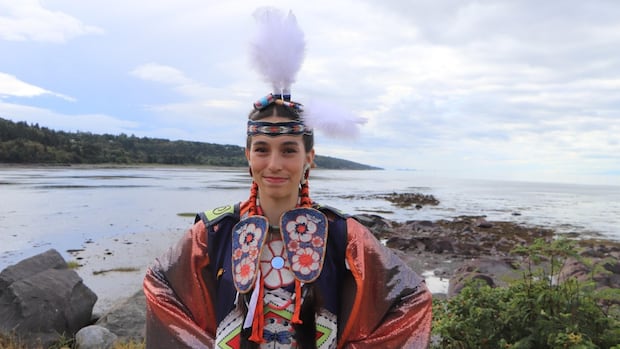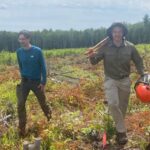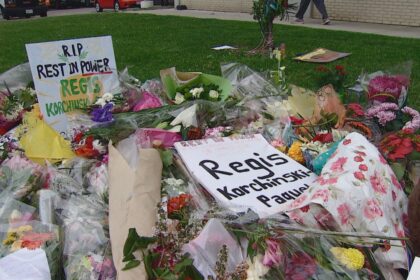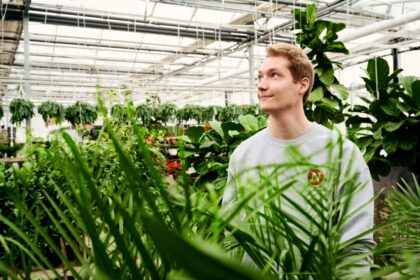Montreal·NewThe Wolastoqiyik Wahsipekuk First Nation was historically allotted the smallest reserve in Canada, but its leaders and members are building projects to unify the community that is spread out across Quebec.Members of Wolastoqiyik Wahsipekuk First Nation revitalizing identity through dance, cuisine, languageJulia Page · CBC News · Posted: Sep 29, 2025 4:00 AM EDT | Last Updated: 30 minutes agoSeventeen-year-old Charlie Lavoie, from the Wolastoqiyik Wahsipekuk First Nation, won the international powwow competition in Wendake in her age category for fancy shawl dance. (Julia Page/CBC)Like nearly all the other 2,200 people who identify as Wolastoqiyik Wahsipekuk in Quebec, Charlie Lavoie has never lived on her nation’s ancestral territory.The land allotted to the First Nation community by the federal government in 1869 became the smallest reserve in Canada, clocking in at under one hectare. It’s limited to a narrow but breathtaking peninsula that juts out into the Saint-Lawrence River in the town of Cacouna, Que., 220 kilometres northeast of Quebec City.Every year, 17-year-old Lavoie travels to the reserve, called Cacouna 22, for the annual powwow held in August. It’s a chance to reconnect with other Wolastoqewi who live across Quebec and New Brunswick. Above all, it’s a reminder of the place where she first learned to dance when she was eight.”For me, dancing is my way to reconnect with my culture. Some will do beading, drumming or crafting, but for me, it’s dancing.”Lavoie danced at the powwow held by the Wolastoqiyik Wahsipekuk First Nation in August. (Julia Page/CBC)At the end of June, Lavoie won the international powwow competition in Wendake in her age category for fancy shawl, a dance that represents a butterfly, with “flamboyant, large movements,” she said. She humbly acknowledges it was a proud moment, but said the prize money and the title mean little to her.”I dance for the people who couldn’t, the children who passed away. I dance for me and I dance for my family.”Local projects breathing new life into regionLavoie’s growing confidence as Wolastoqewi, which means person from the beautiful generous river, is reflected in many of the budding projects being spearheaded locally — from an attention-grabbing beluga observatory, to partnerships in the Alliance de l’énergie de l’Est windmill project, to celebrating local gastronomy.”I think people are proud, even prouder of their nation [thanks to] all the projects that are going on right now. The restaurant is only one among all of them,” said Maxime Lizotte, the head chef and stakeholder at the Maqahamok pub, which opened this summer.Maxime Lizotte, head chef at the Maqahamok pub in Cacouna, was recruited by the Wolastoqiyik Wahsipekuk First Nation to integrate traditional Wolastoqey elements on the menu. (Julia Page/CBC)Lizotte grew up in Quebec City and fell in love with cooking at culinary camp when he was 11. It’s around that time that he found out his great-grandmother was Wolastoqewi.He slowly learned about the traditional techniques and ingredients his ancestors would have favoured — like foraged mushrooms and herbs used to enhance the flavours of the seafood harvested in the Saint-Lawrence River, called Wahsipekuk in the Wolastoqey language.”We always had in history a precious link with water,” said Lizotte.Most of the seafood on customers’ plates comes from the Wolastoqiwik’s fishing boats, from sea urchins, to redfish, Nordic shrimp and red tuna.For the first time, in 2025, three exploratory fishing licences were given out by Fisheries and Oceans Canada to the First Nation community to fish lobster off the coast of Rimouski, Que.”We try to give [space] to those products on the menu and be proud of our territory,” Lizotte said.Kevin Morais said the band council had been looking for an opportunity to open a restaurant in Cacouna for some time when a building on the town’s main drag became available.”It’s an important project for us because it gives visibility to the nation and it allows us to share some of our culture,” said Morais, the chief councillor responsible for culture, infrastructure and governance for the Wolastoqiyik Wahsipekuk First Nation.The logo of the pub incorporates a canoe to reflect the Wolastoqewi’s close relationship to water. Morais says these are things his grandfather would not have been as loquacious about.Kevin Morais, the chief councillor responsible for culture, infrastructure and governance for the Wolastoqiyik Wahsipekuk First Nation, says one of the projects the band council is working on is a new tourism centre that would replace the building behind him on Highway 132 in Cacouna. (Julia Page/CBC)”He was hesitant, very hesitant, to speak about his Indigenous heritage,” said Morais, who grew up in the Saguenay–Lac-Saint-Jean region.But things started changing around 1989, when the provincial government recognized the Maliseet of Viger, the former name of the Wolastoqiyik Wahsipekuk, as the 11th First Nation in Quebec. “My parents’ generation developed that sense of pride. Everything changed,” Morais said.Language revitalizationBetween the growing popularity of the powwow and with more and more tourists visiting the local sites, Morais speaks of an “effervescence” he hasn’t experienced since he first took office in 2016.The council was taken aback by the enthusiasm for the Putep ‘t-awt beluga observatory , a project that opened in 2024 in collaboration with Quebec’s leading marine mammal researchers.The Putep ‘t-awt beluga observatory was named as one of the World’s Greatest Places to visit in 2024 by Time Magazine. (Rachel Watts/CBC)More than 23,000 people visited the site during the first summer, with 4,600 taking part in the guided tour.”It’s a window into the beluga population, but it’s also a window into our nation,” said Morais.No border between communitiesAs visitors walk up the path to the observation deck, they are met with signs explaining the history of the Wolastoqewi in Quebec and of the six Wolastoqey communities in New Brunswick, including the Tobique First Nation.Allan Tremblay, from Tobique, is one of few people who can speak Wolastoqey Latuwewakon fluently. He was consulted to find the new name that replaced Maliseet and was invited to open the ceremony on the last day of the annual powwow.His great-grandfather was from the Cacouna region. “The Tremblays, Nicolases, Bernards, Laportes — we all have the same names here and in Tobique, so our roots are here.”Allan Tremblay, of the Tobique First Nation in New Brunswick, the largest rural Wolastoqiyik community, says the powwow in Cacouna has grown over the years. (Julia Page/CBC)He also worked on a dictionary project with his family, who kept speaking the language “even though they used to punish us for speaking our language or even talking about our culture” in Indian Day School, Tremblay said.”Somehow it stayed with me because that’s all my mother spoke at home and my grandparents, uncles and aunts and everybody.” It’s a tradition Tremblay has passed on to his daughter.”She works with the language now and I’m helping her constantly.”The annual powwow held on the reserve in August is a chance to reconnect with Wolastoqewi who live across Quebec and New Brunswick. (Julia Page/CBC)For Lavoie, at just 17, she already knows her legacy to the younger generation will be passing on what she’s learned through dance.”There aren’t a lot of dancers in my community. I’m the first fancy shawl dancer, so I’m like a model for those little girls. I’m proud of it,” she said.ABOUT THE AUTHORJulia Page is a radio and online journalist with CBC News, based in Quebec City.
Friday, 14 Nov 2025
Canada – The Illusion
Search
Have an existing account?
Sign In
© 2022 Foxiz News Network. Ruby Design Company. All Rights Reserved.
You May also Like
- More News:
- history
- Standing Bear Network
- John Gonzalez
- ᐊᔭᐦᑊ ayahp — It happened
- Creation
- Beneath the Water
- Olympic gold medal
- Jim Thorpe
- type O blood
- the bringer of life
- Raven
- Wás’agi
- NoiseCat
- 'Sugarcane'
- The rivers still sing
- ᑲᓂᐸᐏᐟ ᒪᐢᑿ
- ᐅᑳᐤ okâw — We remember
- ᐊᓂᓈᐯᐃᐧᐣ aninâpêwin — Truth
- This is what it means to be human.
- Nokoma












